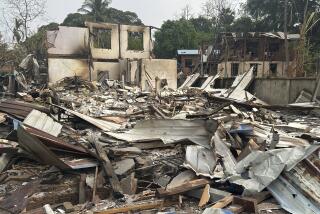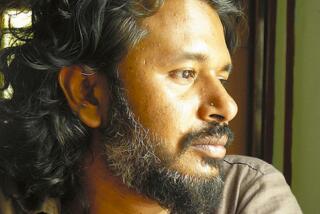Rebels Shift Targets as Sri Lanka Military Shapes Up
- Share via
NEW DELHI — Friday’s bloody terrorist attack in Sri Lanka was the worst such incident since Tamil guerrillas assaulted a Buddhist shrine two years ago and killed 146 Sinhalese.
Until the attack on the Anuradhapura shrine, guerrilla activity in the four-year-old civil war had been aimed almost exclusively at government military forces. It was the undisciplined, poorly trained Sri Lankan army that was most often accused of killing civilians.
But now the military is twice the size it was two years ago and has new equipment that includes patrol boats from Israel and armored personnel carriers from South Africa. It has become a more effective and professional fighting force, and the Tamils have tended to avoid confrontations with it in favor of attacks against civilians.
Tamils Divided, Outgunned
Only three weeks ago, Tamil guerrillas killed 25 Sinhalese villagers near the northern city of Polonnaruwa. Such attacks reflect the desperation of the outmanned and outgunned Tamils, whose effectiveness has been undermined by bitter differences among themselves.
These developments appear to reflect a fundamental shift in the military balance in the conflict, which has taken at least 5,000 lives in the past four years.
Interviews in the past few days with rebel leaders based in the Indian city of Madras and with Sri Lankan officials and Western diplomats in Colombo, the Sri Lankan capital, suggest that after years of conflict, the government forces have gained overwhelming military superiority.
The once-ridiculed army has established dozens of new bases in areas once controlled by Tamil insurgents, including strongholds of the Liberation Tigers of Tamil Eelam--the largest of several rebel groups fighting for an independent Tamil homeland that would be called Eelam and the group blamed by the government for Friday’s attack.
“Our position on the ground is much more advantageous than ever before,” a senior Sri Lankan official said in Colombo. “The Tigers are becoming a little more vulnerable as a consequence.”
Gen. Cyril Ranatunga, who was trained at Sandhurst, the British military academy, came out of retirement 18 months ago to lead the Sri Lankan forces. Under his direction, the military has grown to nearly 40,000 men. And in addition to the regular military, there are about 20,000 men in the lightly armed “home guard.”
5,000 Tamil Guerrillas
Aligned against these forces are no more than 5,000 poorly armed Tamil guerrillas, most of them now concentrated in the Jaffna peninsula at the northern tip of the country, an island that until 1972 was called Ceylon.
Sinhalese, who are largely Buddhist, account for almost 75% of Sri Lanka’s population. The so-called Ceylon Tamils, most of them Hindu, make up about 13%, and another group of Tamils, the so-called Indian Tamils, about 6%. Most of the Indian Tamils live in the mountainous tea-growing areas and have not been involved in the violence, which goes back to the end of British colonial rule in 1948. Other ethnic groups include Muslims, descendants of European settlers, and aborigines.
Under the British, the Tamils enjoyed a status in government and business out of proportion to their numbers. But after independence, the majority Sinhalese began to exercise their political strength. In 1956, the Sinhala language was made the national language by law, a step that the Tamils regarded as insulting.
In 1977 and again in 1983, Sinhalese mobs attacked Tamils in the southern, Sinhalese-dominated areas of the island. After the violence of 1983, in which at least 400 Tamils were killed, the Tamil separatist insurgency in the Tamil-dominated northern areas began to escalate.
Tamils Controlled Pace
The Tamil rebels, with the strong support of the local people, had until recently been able to control the pace and nature of the fighting, and repeatedly embarrassed the government forces.
The government troops, remnants of the small “ceremonial” army that Sri Lanka had before the insurgency began, were mostly confined to their forts. When they did venture out, it was often for retaliatory attacks on the Tamil populace, and the practice earned them a reputation as an undisciplined, unprofessional army.
“They were a parade-ground military,” a Western military expert here said the other day, “and at the first sign of difficulty, they were ready to go out for revenge.”
But since last fall, diplomats and military experts say, the government forces have shown steady improvement in effectiveness and professionalism.
“Around December,” a Western diplomat said, “we started noticing that the army was behaving a whole lot differently. They were more aggressive, and moving well in coordinated sweeps. The militants had to start acting more like guerrillas and get out of the way.”
The military’s effectiveness has been much improved by equipment bought in the past year. The navy has acquired six patrol boats from Israel, and the army has received 30 armored personnel carriers from South Africa--and has begun manufacturing its own APCs using Japanese truck frames.
The air force has bought 12 U.S. helicopters, commercial versions of the UH-1--the “Huey” that was used in Vietnam--and converted them for military use. The air force has also acquired a number of fixed-wing planes from China.
By Third World standards, the military modernization has been expensive--about half a billion dollars.
“For the first time since it began,” a Western diplomat said, “the war is beginning to take a toll on the economy.”
But it is taking a toll in the field, too, and the Tamil Tigers admit it.
“We are rather worried about the massive militarization that is going on,” Anton Balasingham, a spokesman for the Tigers, said in Madras, where the group maintains a propaganda office. “They have staged a massive military offensive against us. Several thousand of their troops have penetrated deep into Tamil territories and put up new camps, consolidating their position.”
The Tigers have demanded that the troops withdraw to pre-offensive positions and lift their economic blockade before they will sit down with government representatives to negotiate a peace.
Still, Tiger leaders are at least discussing the terms of negotiations with government officials. In previous years, anything short of complete independence for the Tamil people was not considered negotiable. Tamil leaders say it was only because of pressure from the Indian government that they took part in the aborted peace negotiations of 1985, in Bhutan.
The most recent government offer to the Tamils included the creation of two Tamil-speaking provinces in the north and northeast and a promise of at least a degree of regional autonomy. The proposals are supported by the Indian government, which calls them a “starting point.”
India Plays a Role
India, just a short distance away across a narrow strait, has been involved in the Tamil struggle from the beginning, offering a haven for several hundred thousand refugees and allowing the Tamil rebels to maintain offices and some training camps in the southern Indian state of Tamil Nadu.
To some extent, India’s hospitality has been a political gesture. Tamil Nadu is home for 50 million Indian Tamils, who share linguistic and cultural ties with the Tamils of Sri Lanka.
But India’s welcome mat has been wearing thin, mainly because of bloody infighting between rival Tamil guerrilla groups that occasionally has spread to Indian territory. Also, some Sri Lankan Tamil militants in India have been involved in a spate of kidnapings and shoot-outs in Madras, the capital of Tamil Nadu, and this has alienated many of their former supporters.
Donald Gnanakone, a Los Angeles-based travel agent who was in Madras recently to negotiate the release of a Tamil businessman kidnaped by one of the rebel organizations, complained that “everybody is playing games out here, and innocent people are getting kidnaped and killed.”
Blames Small Tamil Groups
Gnanakone, a supporter of the Tamil cause, blamed the trouble on small, militant organizations not involved in the actual fighting.
“I feel that the non-fighting militants should be rounded up and cooped up rather than shown the hospitality they have been,” he said.
As a result of the conflict between the Tamil rebel groups, the Liberation Tigers have emerged as the most powerful single group representing the Tamils of Sri Lanka, both militarily and politically.
Because of increased hostility to the rebels’ presence in Tamil Nadu, the Tiger leadership has chosen to move all but its propaganda offices to Sri Lanka, to the Tamil stronghold of Jaffna.
Balasingham said the number of Tigers in the Madras office--which is decorated with posters of Ernesto (Che) Guevara, a hero of the Cuban revolution, pictures of fallen Tamils and a tropical fish tank--has declined from more than 300 to 50.
The mood in Colombo was palpably upbeat recently as the Sinhalese celebrated a Buddhist holiday; but a few days earlier, in India, the atmosphere among Sri Lanka Tamils was relatively grim.
Most of the Tamil rebel offices had either closed or moved. The old headquarters of the Tamil Eelam Revolutionary Organization, a main rival of the Tigers, is now a potato chip factory.
Sri Lanka Tamil supporters complain that they find it increasingly difficult to organize supporters for their cause. The other day, a demonstration called by Tamil refugees to protest government treatment of Tamil prisoners in Sri Lanka attracted fewer than 100 people.
Many Sri Lankan Tamils are bored or frightened. Some of them, former members of defunct fighting groups and now living in homes converted into dormitories in the Madras suburbs, watched an Indian cricket match on television recently and sadly contemplated their future.
“What to do? I don’t know,” said Nicholas Jerome, 42, of Jaffna, where his wife and children still live. “We were born to suffer, I guess, especially the Sri Lanka Tamil.”
More to Read
Sign up for Essential California
The most important California stories and recommendations in your inbox every morning.
You may occasionally receive promotional content from the Los Angeles Times.









